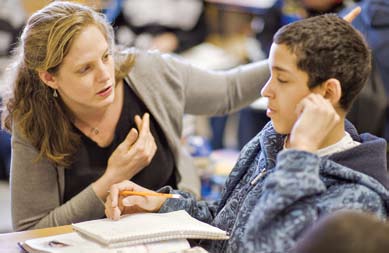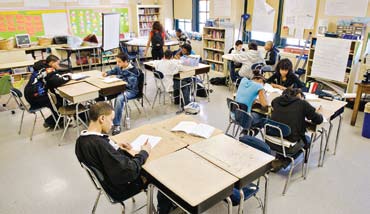Doing the Math
Classes look so small these days at I.S. 123—the
“When we first did it, people would say, ‘You have horrible attendance,’” says Principal Virginia Connelly. Or, she says, “People from Central would mistakenly think we had lots of room to share in the building. I’d say, ‘No, no, no. Go look at my registers. I have 30 to 36 in every homeroom class.’”
Yet through complex programming, artful use of additional state funding and help from an enthusiastic faculty, I.S. 123 has managed to create what Connelly calls “splits” in every English Language Arts (ELA) and math class, resulting in sections of 15 to 18 kids.
The results have been impressive. In 1999, the year after Connelly arrived, 80 percent of her students were performing in the City’s lowest quartile in math. By 2007, that number had dropped to 10 percent, with the remaining 90 percent distributed across levels 2, 3 and 4. The school remains on the City’s SURR (Schools Under Registration Review) list, but last year, it earned an “A” on the new Department of Education school report card, which primarily measures improvement.
A Popular Approach
When it comes to improving student achievement, reducing class size is popularly viewed as a no-brainer—a strategy so self-evidently effective that it ought to be the top spending priority in every district and school in the country. For proof, its champions typically cite
Since Project STAR, hundreds of billions of public and private dollars have been spent nationwide to reduce the size of classrooms and schools, with 32 states now funding either voluntary or mandated class-size reduction programs.
It’s a great story, but there’s just one catch: despite a nearly 40 percent average reduction in
“Reduced class size alone isn’t a silver bullet,” writes Douglas Ready, Assistant Professor of Education at Teachers College, in his Equity Matters research review “Class-Size Reduction: Policy, Politics and Implications for Equity.” “Establishing appropriate class size is a balancing act between children’s development needs and contemporary fiscal realities.” The strategy is politically popular, Ready says, because it makes intuitive sense; because elected officials have the power to enact it (unlike other school reforms, which can be initiated only through a more complex set of steps); and because it can be (and thus far has been) applied to students of all income levels. And yes, he says, studies like Project STAR and
A Turnaround Story
I.S. 123 is a case in point. Ten years ago, the school was beset by trouble. Drug dealers and gang recruiters regularly hung out outside. A gang riot erupted just before Connelly arrived in May 1998, resulting in the arrests of 20 students, and another riot was narrowly averted after the nearby police shooting of Amadou Diallo. Connelly’s top priority coming in was to “make the 123 campus a model for middle schools.”
Today, life at 123 has significantly improved. Two years ago, Connelly declared that any mark lower than a 75 was unacceptable. “Now there’s no such grade,” she says. “It’s an ‘N,’ which means you’re not done. Not done, need improvement.”
Kids who get an ‘N’ on a test must retake it, with studying help from teachers if necessary, until they get at least a 75. That’s led to a dramatic increase in the school’s list of honor students: two years ago, 110 kids made the list, while 260 were failing. This year there are 180 kids on the honor roll and the number of those failing could dip under 100 for the first time.
Still, as she walks through the hallways, Connelly constantly picks up pieces of paper and pulls hoods and hats off students.
“We’re not accepting anything less than your best,” Connelly says.
That maxim extends to teachers, who are essential to the success of the school’s smaller classes. To pay for quality teachers, Connelly has drawn in part on new state money designated for class size reduction, but she’s also used savings created by cutting some non-teaching jobs and persuading teachers to volunteer to deal with detention at lunchtime and help with interim and periodic assessments. The incentive she offers: classes of just 18 kids.
A Citywide Approach
These are precisely the kinds of thoughtful strategies and trade-offs encouraged by the New York City Department of Education (DOE). Under a state law resulting from
“We didn’t go to any school and say, ‘You must reduce classes,’” says Garth Harries, DOE’s Chief Executive for Portfolio Development, who reports to Chancellor Joel Klein. “We gave schools a broad range of additional resources. Last year, schools opted to use about half of that money for class size reduction and half for other targeted reforms.”
When schools do choose to undertake class size reduction, Harries says, the DOE pushes them to “make smart tradeoffs. Class size reduction happens at the nexus of teachers’ time and the availability of facilities. So you have to make sure you have the best caliber teachers you can have. You have to understand how to use your physical infrastructure and how to do your scheduling. Class size reduction makes intuitive sense, but it’s actually a pretty complex business.”
Or as Doug Ready puts it: “Meaningful education reforms require much deeper transformations than class size reduction alone can provide.”
When those deeper transformations occur, though, there are few complainers. A few years ago, Barry Price, a math teacher at 123, was so stressed out from teaching larger classes that his doctor recommended anti-hypertensives. Now, the kids in his long, bright classroom work quietly in groups, enabling Price to directly supervise students at the smart board.
In particular, Price is able to help struggling students like Maxwell Alvarez. “I couldn’t reach him,” he says. “He’s the guy who would be in the back. He doesn’t cause any problems. All his life he’s going to get pushed along because he doesn’t cause any problems. And bad teachers are going to say, you don’t cause any problems, I’ll pass you. But now, he’s not getting lost, because I see it. I can physically see why he’s stuck. And I have the time to say, here—here’s the exact point you’re missing.”Published Tuesday, May. 20, 2008



